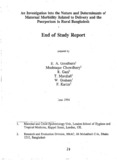| dc.identifier.citation | Goodbum, E. A., Chowdhury, M., Gazi, R., Marshall, T., Graham, W., & Karim, F. (1994, June). An investigation into the nature and determinants of maternal morbidity related to delivery and the puerperium in rural Bangladesh. Research Reports (1994): Health Studies, Vol - XlV, 18–123. | en_US |
| dc.description.abstract | It has been estimated that 99% of the world's maternal deaths (currently estimated to be about
. 500,000 per annum) occur in developing countries. In Bangladesh, as in many other resource
·poor countries, the maternal mortality ratio has been estimated at between 5 .and 6 deaths per
.1 000 live births. The main medical causes of these deaths are haemorrhage, infection, eclampsia,
obstructed labour and septic abortion.
Far less is known about the nature, determinants, levels and ~ends of maternal morbidity than
· is known about maternal mortality. Until recently it was thought that there might be about 16.5
morbidities for every maternal death. More recent estimates· suggest that this figure is far too
low and that there may be as many as 100 morbidities for every death meaning that more than
61.8 million women suffer significant ill health annually as a result of childbearing.
Studies of maternal deaths which have investigated the timing of maternal deaths show that the
majority occur in the post-partum period. It seems likely that most maternal morbidities arise
at this time also and are linked to events at delivery. These conditions which include pelvic
sepsis, anaemia, prolapse, vesico-vaginal fist~la and prolapse, may not result in death but may
have serious social and physical consequences for women. ·
There have been very few community based studies of maternal morbidity in the post-partum
period. One study from Honduras has reported that 28% of women developed complications
during the puerperium, but in most countries facility based data is all that is available. Studies
which have measured the prevalence of conditions which are long-term consequences of
childbirth have often found that the prevalence can be very high. For instance, a recent crosssectional
community based study conducted in Egypt discovered that 56% of .508 women
examined had demonstrable prolapse. A study in Birmingham UK found that the number of
women suffering significant ill health as a result of childbirth was as high as 6~.9%. A recent
cross-sectional retrospective study of maternal morbidity in Bangladesh found that around 80%
of women reported ill health associated with childbearing.
One of the major issues in the estimation of levels of maternal morbidity in the community
centres around the measurement techniques needed to provide accurate information. Compared
to child health, very little work has been done in this field. Since 1989 a group based at the
London School of Hygiene and Tropical Medicine (LSHTM) has co-ordinated a programme of
methodological research on maternal health with the objective of evaluating existing methods of
measuring maternal health, particularly in the community, and of developing, piloting and
promoting the use of new approaches.
Most interventions to improve maternal morbidity and mortality have focused on ante-natal care
with referral of high risk cases to appropriate medical facilities. However, there has been
considerable debate as to the value of ante-natal care in a situation where referral facilities are
11
20
absent or inadequate. In addition, in many countries, such as Bangladesh, where most deliveries
occur at home, there have been programmes for training traditional birth attendants. However,
it is uncertain how far delivery practices play a part in the aetiology of maternal morbidities, and
the effectiveness of the interventions in prevention have never been adequately evaluated. Postpartum
care is rarely given prominence in programmes for maternal care and no protocol for
optimum surveillance has been developed despite recent interest in the potential of this period
for integrated maternal, child and family planning interventions.
In order to describe the pattern of maternal morbidity during the puerperium in Bangladesh,
define the most important determinants of this morbidity and suggest approaches for future
postnatal programmes a collaborative research study was undertaken by BRAC, ar1d the London
School of Hygiene and Tropical Medicine (LSHTM). | en_US |

